GIGABYTE X99-Gaming G1 WIFI Motherboard Review
by Ian Cutress on December 18, 2014 10:00 AM ESTCPU Performance
Readers of our motherboard review section will have noted the trend in modern motherboards to implement a form of MultiCore Enhancement / Acceleration / Turbo (read our report here) on their motherboards. This does several things, including better benchmark results at stock settings (not entirely needed if overclocking is an end-user goal) at the expense of heat and temperature. It also gives in essence an automatic overclock which may be against what the user wants. Our testing methodology is ‘out-of-the-box’, with the latest public BIOS installed and XMP enabled, and thus subject to the whims of this feature. It is ultimately up to the motherboard manufacturer to take this risk – and manufacturers taking risks in the setup is something they do on every product (think C-state settings, USB priority, DPC Latency / monitoring priority, memory subtimings at JEDEC). Processor speed change is part of that risk, and ultimately if no overclocking is planned, some motherboards will affect how fast that shiny new processor goes and can be an important factor in the system build.
For reference the X99-Gaming G1 WIFI did not use MultiCore Turbo on BIOS F8c that we used.
Point Calculations – 3D Movement Algorithm Test: link
3DPM is a self-penned benchmark, taking basic 3D movement algorithms used in Brownian Motion simulations and testing them for speed. High floating point performance, MHz and IPC wins in the single thread version, whereas the multithread version has to handle the threads and loves more cores.
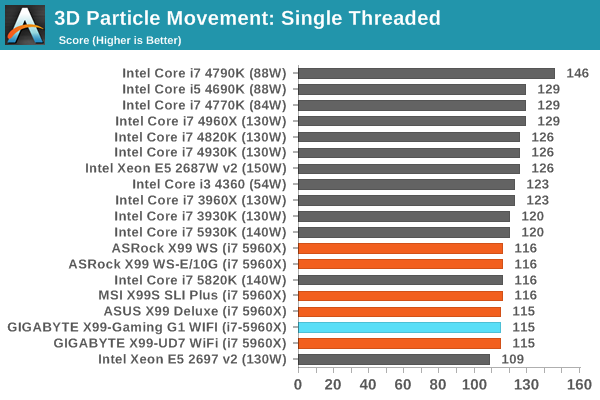
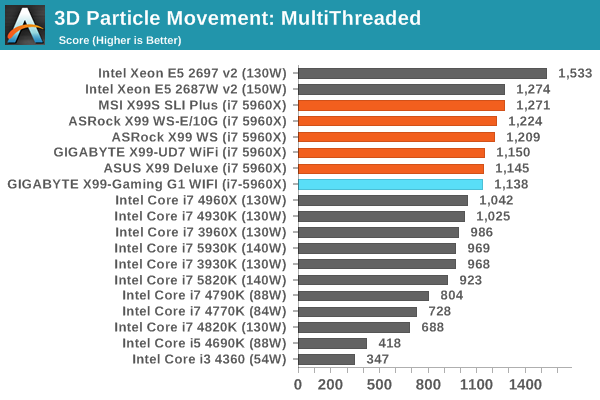
Compression – WinRAR 5.0.1: link
Our WinRAR test from 2013 is updated to the latest version of WinRAR at the start of 2014. We compress a set of 2867 files across 320 folders totaling 1.52 GB in size – 95% of these files are small typical website files, and the rest (90% of the size) are small 30 second 720p videos.
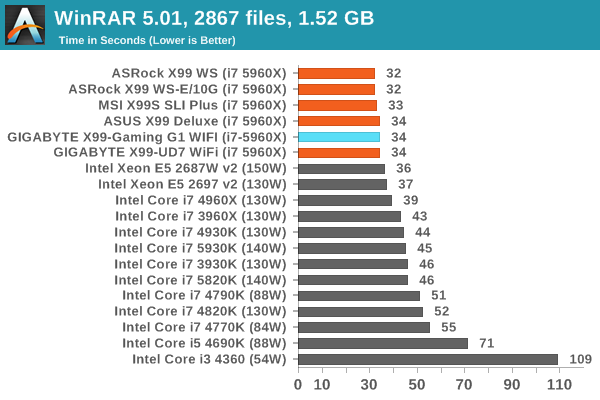
Image Manipulation – FastStone Image Viewer 4.9: link
Similarly to WinRAR, the FastStone test us updated for 2014 to the latest version. FastStone is the program I use to perform quick or bulk actions on images, such as resizing, adjusting for color and cropping. In our test we take a series of 170 images in various sizes and formats and convert them all into 640x480 .gif files, maintaining the aspect ratio. FastStone does not use multithreading for this test, and thus single threaded performance is often the winner.
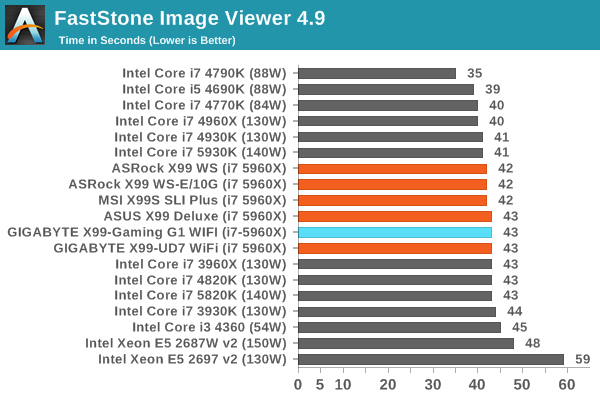
Video Conversion – Handbrake v0.9.9: link
Handbrake is a media conversion tool that was initially designed to help DVD ISOs and Video CDs into more common video formats. The principle today is still the same, primarily as an output for H.264 + AAC/MP3 audio within an MKV container. In our test we use the same videos as in the Xilisoft test, and results are given in frames per second.

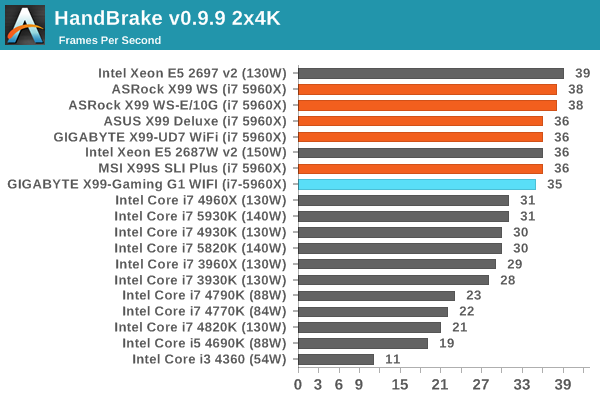
Rendering – PovRay 3.7: link
The Persistence of Vision RayTracer, or PovRay, is a freeware package for as the name suggests, ray tracing. It is a pure renderer, rather than modeling software, but the latest beta version contains a handy benchmark for stressing all processing threads on a platform. We have been using this test in motherboard reviews to test memory stability at various CPU speeds to good effect – if it passes the test, the IMC in the CPU is stable for a given CPU speed. As a CPU test, it runs for approximately 2-3 minutes on high end platforms.
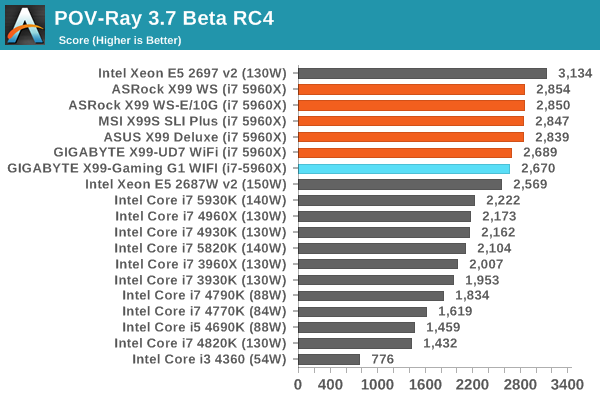
Synthetic – 7-Zip 9.2: link
As an open source compression tool, 7-Zip is a popular tool for making sets of files easier to handle and transfer. The software offers up its own benchmark, to which we report the result.











16 Comments
View All Comments
Meegul - Thursday, December 18, 2014 - link
The aesthetic of the motherboard would be nice. That is, if it weren't for those green capacitors by the audio chip. Seriously, with a good looking red and black motherboard, what is such a color doing on it? Otherwise, it looks like a pretty good motherboard, albeit a bit pricey even for an X99 motherboard.chizow - Thursday, December 18, 2014 - link
They're colored that way because Nichicon makes them that way and has for years. Audiophiles who know the difference will notice this immediately and prefer this over a black or red tinned version.https://www.google.com/search?q=nichicon+audio+cap...
Unfortunately for this board, the Nichicon audio caps aren't enough to save the lackluster sound output, which ends up sounding extremely low bitrate and crushed/dumpy at higher output levels (adjusting input load level does not help).
If you have a few add-in boards installed, chances you don't see these caps anyways.
stux - Thursday, December 18, 2014 - link
[img]http://www.hardwareheaven.com/reviewimages/gigabyt...[/img]leetruski - Friday, December 19, 2014 - link
Those look like electrolytic capacitors rather than solid state. Is there a particular reason as to why they would have gone with those? Seem kind of out of place on a premium board.JeffFlanagan - Friday, December 19, 2014 - link
>Unfortunately for this board, the Nichicon audio caps aren't enough to save> the lackluster sound output
Who's still using onboard sound output? Audiophiles will use the USB DAC-UP ports to attach a nice external DAC, and the rest of us are using HDMI audio. A motherboard is about the worst place possible to encode audio due to all the electrical noise from the rest of the MB.
Stuka87 - Thursday, December 18, 2014 - link
The board looks nice, and has a ton of great features (3 year warranty is nice). Although I really question the built in wifi on a gaming board. Wifi is terrible for gaming. Random latency spikes make online gaming an aggravating experience.Morawka - Thursday, December 18, 2014 - link
ever heard of wifi direct? you'll need it for xbox one controllers, Nvidia shield controllers, etc..there are tons of wifi direct hardware on the market nowadays.
imaheadcase - Friday, December 19, 2014 - link
So? Still does not change the fact wifi is terrible for gaming.chizow - Friday, December 19, 2014 - link
I think the point is, its not either/or, it can be both. You can always hardwire your ethernet connection and use the wifi direct for connecting peripherals that use it for the best of both worlds...aliquis - Monday, March 5, 2018 - link
Hi Morawka.I just want to know how that WiFi Direct Connection using your Xbox One or Nvidia Shield controller is working for you ...
Even if it worked with any wireless card which the later doesn't do AFAIK and likely not the former either the Nvidia Shield one also need to have an Nvidia graphics card so it's complete garbage.
It's disturbing Valve doesn't have Steam controller support built in in their Steam Link =P